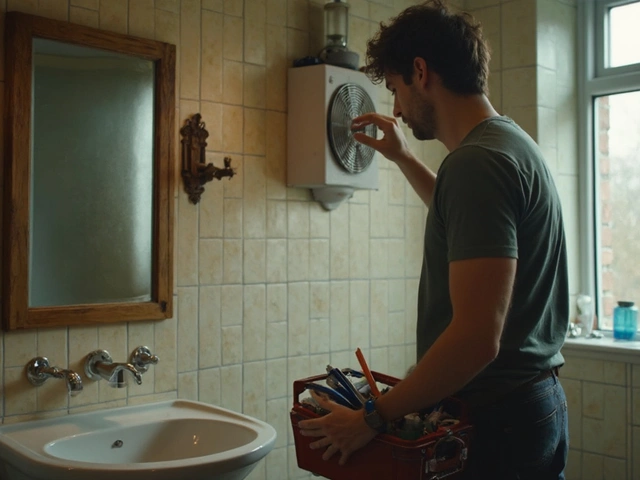Fresh air in the kitchen or bathroom isn’t a luxury, it’s a must. When your extractor fan gets noisy, stops working, or just looks worn out, you don’t need to call a pro right away. With the right tools and a bit of patience you can swap the fan yourself in under an hour. This guide walks you through everything you need, step by step.
Before you start, gather a few basic tools: a screwdriver set (Phillips and flat‑head), a drill with a small bit for any screw caps, wire strippers, and a flashlight. You’ll also need a new fan that matches the size and airflow rating of the old one – most residential fans are 100mm or 150mm in diameter. Safety matters, so turn off the electricity at the consumer unit. Double‑check the circuit is dead with a voltage tester; you don’t want a surprise shock while you’re working.
If the fan is in a bathroom, make sure the area is dry and the walls are clean. A damp environment can hide moisture that could affect your new fan’s wiring. Also, keep a fire‑extinguishing blanket nearby just in case you accidentally strip a wire.
1. Remove the old cover. Most fans have a plastic grille held by clips or a few screws. Gently pry the clips apart or unscrew the fasteners, then set the cover aside.
2. Disconnect the wiring. You’ll see two or three wires – usually live (brown), neutral (blue) and sometimes earth (green/yellow). Loosen the terminal screws, note which wire goes where, then pull the connectors off. If the wires are capped, cut the caps off with wire strippers.
3. Unscrew the fan unit. The fan sits on a metal or plastic frame attached to the ceiling or wall. Use the screwdriver to remove the mounting screws, then pull the fan out of the opening. Some models have a quick‑release clip; just press the release and lift.
4. Prepare the new fan. Attach the new fan’s mounting bracket to the existing frame if it’s not pre‑installed. Make sure the fan sits level – an uneven fan can cause vibration and noise.
5. Wire the new fan. Match the live, neutral, and earth wires to the terminals on the new unit. Tighten the screws securely, but don’t over‑tighten – you could strip the screw heads. Wrap each connection with a bit of electrical tape for extra safety.
6. Fit the fan and secure it. Slide the fan back into the opening and align the mounting holes. Re‑insert the screws and tighten them evenly. If the fan came with a rubber gasket, place it now to prevent drafts.
7. Replace the grille. Snap or screw the cover back on. Make sure it clicks into place and there are no gaps.
8. Test the fan. Switch the circuit back on at the consumer unit. Turn the fan on – you should hear a steady hum and feel air moving. If it’s silent or makes a grinding noise, double‑check the wiring and mounting.
That’s it. You’ve just replaced an extractor fan without hiring anyone. Regular cleaning of the grille and checking the fan’s motor will keep it running smoothly for years.
Still not sure if you can do it yourself? The biggest hurdle is the electrical connection; if your wiring looks damaged or you feel unsure, a qualified electrician can finish the job in minutes. Otherwise, enjoy the fresh airflow and the satisfaction of a job well done.

Wondering if you can change your kitchen extractor fan yourself? This guide covers steps, safety, tools, common mistakes, and installation tips for a smooth DIY experience.

Thinking about swapping out your old extractor fan? This guide digs into how easy (or not) it really is to replace an extractor fan in your bathroom or kitchen. Get the lowdown on what tools you'll need, common surprises people miss, and what makes some fans trickier than others. If you're not sure when to call in a pro, we've got your back there, too. Get ready for a clear, no-nonsense breakdown.

Deciding whether to repair or replace a laptop can be challenging. This guide explores the costs, benefits, and considerations involved in repairing a laptop. Learn when it's worth diving into a repair and when it's best to shop for a new device, along with tips on DIY repairs and choosing a reliable repair service.

Proper appliance maintenance can save money, extend lifespan, and keep everything running smoothly at home. Learn about essential maintenance tips for common household appliances and understand why some regular attention can go a long way. Dive into practical tips and advice that are easy to apply and can prevent inconvenient breakdowns.

Stuck between fixing or swapping your boiler? Discover the real facts, costs, tips, and how to make the right call for your property, budget, and comfort.

Ever got frustrated with cold showers while waiting for your hot water heater to get fixed? This article breaks down how long it really takes to repair different types of water heaters, from common issues you can fix yourself to problems that call for a pro. You'll learn what affects the repair timeline, plus some quick tips to speed things up. No more second-guessing if you’ll be stuck with icy water all day. Get the facts so you can plan around your next repair.